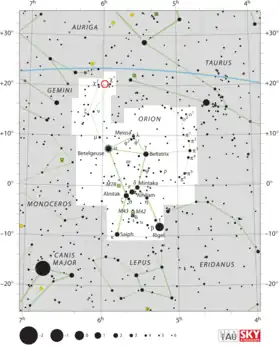 | |
| Observation data Epoch J2000 Equinox J2000 | |
|---|---|
| Constellation | Orion |
| Right ascension | 05h 58m 20.146s[1] |
| Declination | +20° 15′ 45.35″[1] |
| Characteristics | |
| Variable type | Nova? |
| Other designations | |
| Database references | |
| SIMBAD | data |
V529 Orionis, also known as Nova Orionis 1678, is a variable star which is usually classified as a nova. It was discovered on 28 March 1678 by Johannes Hevelius, who spotted it while observing a lunar occultation of χ1 Orionis, the star that forms the northernmost tip of Orion's club. Following the occultation of χ1 Orionis, Hevelius observed the occultation of another star by the Moon a few minutes later, which disappeared behind the first quarter Moon at 09:16 and reappeared at 10:29. Those details, combined with modern coordinates for χ1 Orionis, allowed Ashworth to derive coordinates, probably accurate to within a few arc seconds, for the 1678 nova.[3][4]
V529 Orionis is sometimes referred to as Nova Orionis 1667 (for example the Simbad database makes this identification), but Ashworth argues against this identification[4] and the identification of the star during an occultation makes the year unambiguous. The maximum and minimum apparent magnitudes for this star are highly uncertain, but a peak brightness of magnitude 6 (barely visible to the naked eye) and a minimum of 20 was suggested by Duerbeck.[5]
Schmidtobreick et al. argue that the lack of emission lines usually seen in the spectra of novae makes it doubtful that V529 Orionis was a nova. They suggest it may instead be a T Tauri star, and that the actual nova observed by Hevelius may still be unidentified.[3]
References
- 1 2 Brown, A. G. A.; et al. (Gaia collaboration) (August 2018). "Gaia Data Release 2: Summary of the contents and survey properties". Astronomy & Astrophysics. 616. A1. arXiv:1804.09365. Bibcode:2018A&A...616A...1G. doi:10.1051/0004-6361/201833051. Gaia DR2 record for this source at VizieR.
- ↑ "V529 Orionis". SIMBAD. Centre de données astronomiques de Strasbourg. Retrieved 2020-12-10.
- 1 2 Schmidtobreick, L.; Tappert, C.; Bianchini, A.; Mennickent, R.E. (March 2005). "Spectroscopic analysis of tremendous-outburst-nova candidates". Astronomy & Astrophysics. 432 (1): 199–205. arXiv:astro-ph/0411198. Bibcode:2005A&A...432..199S. doi:10.1051/0004-6361:20041371. S2CID 18168602.
- 1 2 Ashworth, W.B. (March 1981). "A rejection of nova Orionis 1667, with a suggestion of a possible nova Orionis 1678". Quarterly Journal of the Royal Astronomical Society. 22: 22–27. Bibcode:1981QJRAS..22...22A.
- ↑ Duerbeck, Hilmar W. (March 1987). "A Reference Catalogue and Atlas of Galactic Novae". Space Science Reviews. 45 (1–2): 1–14. Bibcode:1987SSRv...45....1D. doi:10.1007/BF00187826. S2CID 115854775.